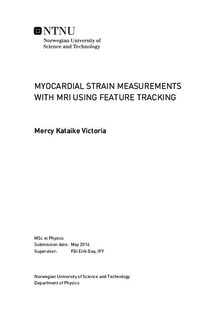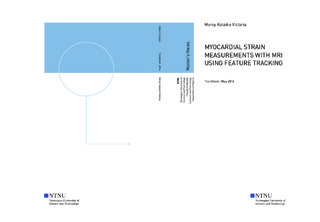| dc.description.abstract | Myocardial strain is increasingly used in determination of myocardial function in the medical field due to its ability to detect cardiac diseases in the early stages, its ability to quantify regional myocardial function and its prognostic power.
A number of methods have been developed to measure myocardial strain in Ultrasound, MRI and Computed Tomography. In the area of Ultrasound, Doppler imaging and Speckle Tracking Echocardiography are used to determine myocardial strain. Of the two, Speckle Tracking Echocardiography is preferred because it is angle independent and can be carried out in 2D and nowadays in 3D.
The standard for strain measurement in Cardiac MRI and in deformation imaging in general is myocardial tagging. Recently, a semi-automatic software-based method has been developed in Cardiac MRI and is known as Feature Tracking. Currently there are three software algorithms available for use; TomTec 2D Cardiac Performance Analysis MR (TomTec 2D CPA MR), Multimodality Tissue Tracking and CMR42 Tissue Tracking (CMR42 TT).
In this project, the Feature Tracking method was evaluated with Speckle Tracking Echocardiography, a software-based method in the Ultrasound field that is already established. 10 healthy volunteers underwent one Ultrasound scan and two MRI scans 6 months apart. Strain analysis in both Ultrasound and MRI was done offline.
Differences between strain values from TomTec 2D CPA MR and CMR42 TT software algorithms and Speckle Tracking Echocardiography were assessed using One-way ANOVA. With TomTec 2D CPA MR and STE, circumferential strain values were not statistically different (P = 0.913) while longitudinal strain values were statistically different (P = 0.006). For CMR42 TT and STE, circumferential strain values and longitudinal strain values were not statistically different (P > 0.05). In the comparison of both Feature Tracking software methods, TomTec 2D CPA MR and CMR42 TT, the strain values from all the three strain views were statistically different (P < 0.05).
Interobserver reproducibility of TomTec 2D CPA MR was good with CV=7.00% for circumferential strain, CV=15.54% for longitudinal strain, and CV=19.13% for radial strain.
Intraobserver reproducibility of CMR42 TT was high. It gave CV of 6.81%, (ICC=0.84) for circumferential strain, CV of 10.54%, (ICC=0.54) for longitudinal strain, and CV of 9.33%, (ICC=0.83) for radial strain.
Interstudy reproducibility for baseline and control measurements was high and it gave the following results for TomTec 2D CPA MR: CV=7.88% for circumferential strain, CV=14.44% for longitudinal strain and CV=6.24% for radial strain. The results from CMR42 TT were: CV=9.45% for circumferential strain, CV=9.22% for longitudinal strain and CV=14.63% for radial strain.
The interstudy reproducibility of both TomTec 2D CPA MR and STE, as well as CMR42 TT and STE was high with CV=9.26% and CV=11.09% respectively for circumferential strain, CV=14.83% and CV=8.64% respectively for longitudinal strain. Interstudy reproducibility of the FT software methods was good with CV=14.49% for circumferential strain, CV=13.62% for longitudinal strain, and CV=23.21% for radial strain.
The greatest contributor to the variance of the strain results was the variance due to the FT software methods. | |

